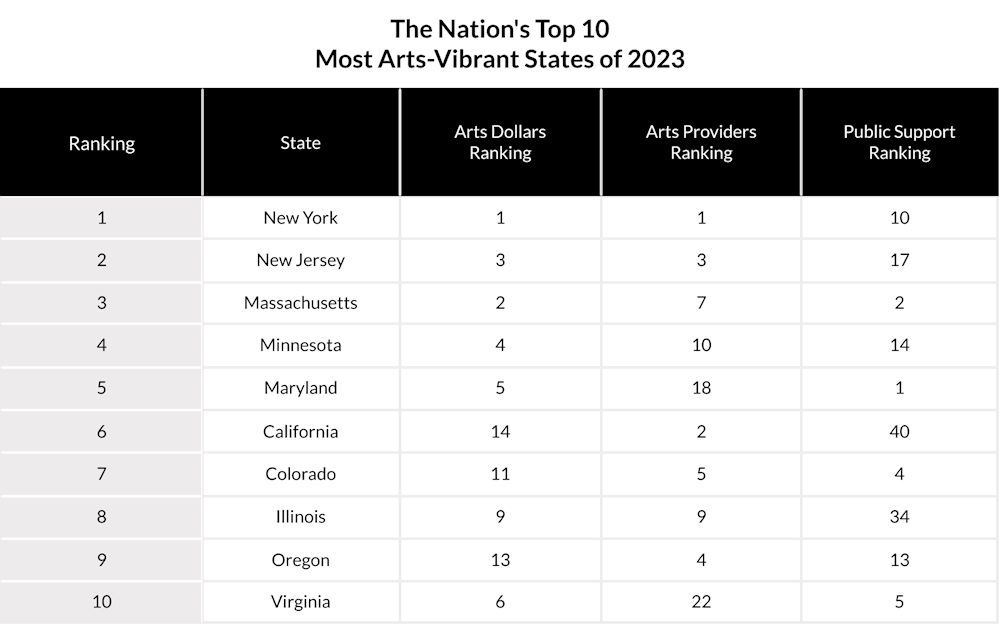SMU DataArts Releases Ranking of Most Arts-Vibrant States in the U.S.
- Posted Mar 14, 2024
States Ranked by Per Capita Supply, Demand and Government Support for the Arts
Dallas (SMU), March 14, 2024 – SMU DataArts, the National Center for Arts Research, today released the first ever Arts Vibrancy State Rankings. The rankings are based upon SMU DataArts’ Arts Vibrancy Index, which identifies the most arts-vibrant areas in the United States through an analysis of the level of supply, demand, and government support for the arts across the country.
The release is accompanied by a map visualizing arts vibrancy levels in all 50 states, as well as a data explorer featuring the overall rankings for all 50 states and rankings on each of the 13 unique measures of arts vibrancy included in the Arts Vibrancy Index.

The release also explores connections between vibrancy and three other state-level factors: rural/urban population, poverty levels, and the presence of arts-vibrant cities. Key findings include:
- States with higher proportions of rural population tend to have lower levels of arts vibrancy –with some notable exceptions. Vermont and Maine have the two highest rural populations in the county and have arts vibrancy in the top half of all states. Among the top 5 most arts-vibrant states overall, Minnesota stands out with 28% rural population, more than double the percentage rural of any other states in the top five.
- States ranking higher on arts vibrancy generally have lower poverty rates; but having low levels of poverty doesn’t guarantee a top arts vibrancy ranking. The most arts-vibrant state in the country – New York – also has the 15th-highest poverty level. Three other states with poverty levels at or above the national average in 2022 appear in the top half of the arts vibrancy rankings: Missouri, Alaska, and Louisiana.
“This analysis shows us that there is no single path to arts vibrancy. While we found a certain degree of connection between arts vibrancy, wealth, and the presence of arts-vibrant urban areas in a state, there were just as many exceptions that complicate our understanding of where and under what conditions a strong arts sector can thrive,” said Jen Benoit-Bryan, Research Director at SMU DataArts. “We hope that everyone who cares about the arts can access this data to learn more about their state’s unique arts environment, and that advocates, and policymakers can employ it in their efforts to support artists and creatives in their state.”
The overall Arts Vibrancy Index is composed of 13 unique measures which cover aspects of supply, demand, and public support for arts and culture, and are adjusted for cost of living and population differences among communities. In 2023, the analysis approach was updated to weight the 13 inputs based on their relative explanatory power for the underlying concept of arts vibrancy. This approach improves measurement consistency in the face of data availability delays or other changes in individual datasets from year to year. All metrics have been adjusted to per capita measures and financial metrics have been adjusted for cost of living in order to level the playing field across state contexts. The cost of doing business varies based on local conditions, so the same dollar goes further in some communities than others.
ABOUT SMU DATAARTS
SMU DataArts, the National Center for Arts Research, is a project of the Meadows School of the Arts at Southern Methodist University. The mission of SMU DataArts is to provide and engage both organizations and individuals with the evidence-based insights needed to collectively build strong, vibrant, and equitable arts communities. Its research efforts range from academic papers published in leading journals, applied research undertaken with community partners, and actionable insights shared directly with arts practitioners. Its programs provide business intelligence tools and resources to help arts leaders leverage data to answer critical management questions and connect research analyses to their own work. Recent publications include research reports on the scope of COVID-19 federal relief funding for the arts, emergence from the COVID-19 crisis; the alchemy that drives high performing arts organizations of color; audience diversity, equity and inclusion in large performing arts organizations; impact of investments made in diverse creative communities; and more.
###
Media Contact:
Emma England
SMU Meadows School of the Arts
214-768-3785


